GRAVITATIONAL POTENTIAL
Work done per unit mass in shifting a rest mass from some reference point (usually at infinity) to the given point.
![]()
![]()

Potential Energy: it is the energy stored in a body or system by virtue of its configuration or its position in a fields.
F= -dUdr⇒F.dr= -dU![]()
POTENTIAL DUE TO POINT MASS
Suppose a point mass ‘M’ placed at origin (x = 0). We wish to find gravitational potential at P, at a distance ‘r’ from M.
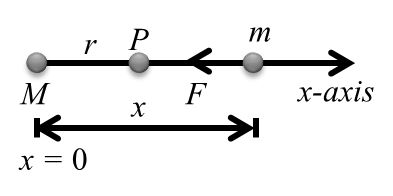
First of all we will calculate the work done by gravitational force in moving a test mass ‘m’ from infinity to P. Gravitational force on ‘m’ when it is at a distance ’x’ from M is
![]() Here, negative sign implies that forces is towards ‘M’ or towards negative x-direction. This is a variable force (a function of x). Therefore, work done is
Here, negative sign implies that forces is towards ‘M’ or towards negative x-direction. This is a variable force (a function of x). Therefore, work done is
![]()
Now, from the definition of potential,
![]()
![]()
Potential due to a Uniform Solid Sphere
Potential at some External Point
The gravitational potential due to a uniform sphere at an external point is same as that due to a single particle of same mass placed at its centre. Thus,
![]()
At the surface, ![]()
Potential at some Internal Point
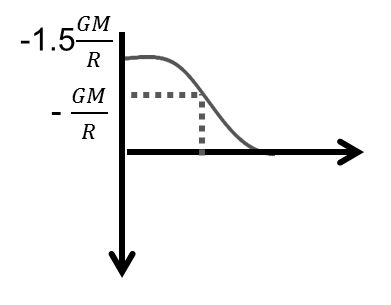
At some internal point, potential at a distance r from the centre is given by,
![]()
![]()
![]()
i.e. at the centre of the sphere the potential is 1.5 times
the potential at the surface. The variation of V versus r
graph is as shown in Fig.
Potential due to a Uniform Thin Spherical Shell
Potential at an External Point
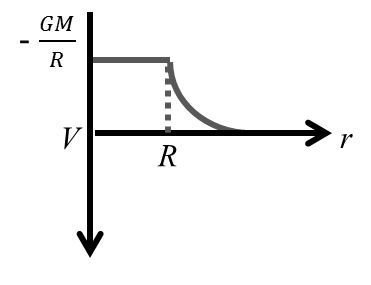
To calculate the potential at an external point, a uniform spherical shell may be treated as a point mass of same magnitude at its centre. Thus, potential at a distance r is given by,
![]()
![]()
Potential at an Internal Point
The potential due to a uniform spherical shell is constant at any
point inside the shell and this is equal .![]() Thus, V-r
Thus, V-r
graph for a spherical shell is as shown in Fig.
Potential due to a Uniform Ring at some Point on its Axis

The gravitational potential at a distance r from the centre on the axis of a ring of mass M and radius R is given by,
![]()
![]()
![]()
The V-r graph is as shown in Fig.
Difference in Potential Energy (D U)
Let us find the difference in potential energy in two positions shown in figure. The potential energy when the mass is on the surface of earth (at B) is,
![]()

and potential energy when the mass m is at height h above the surface of earth (at A) is,
![]()
![]()
![]()
![]()
![]()
![]()
![]()
For h < < R, DU » mgh

Thus , mgh is the difference in potential energy (not the absolute energy), for h < < R.
![]()
Note: For attraction force U → negative
For repulsion force U → Positive
POTENTIAL ENERGY FOR SYSTEM OF PARTICLES
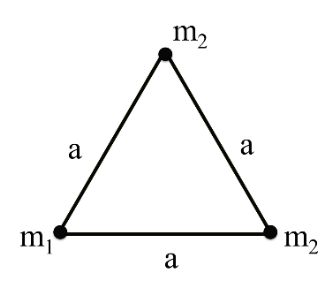
![]()
Potential energy on the surface of earth
U = - mgR (But we can assume is zero)
Potential energy at h height above the earth surface
![]()
If h <<<<<<R
U = mgh

ORBITAL VELOCITY
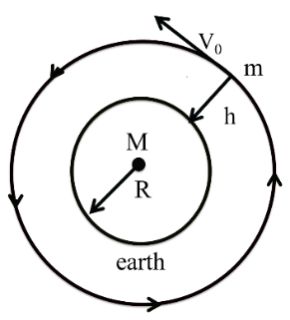
![]()
![]()
![]()
![]()
![]()
![]()
Time period
![]()
![]()
![]()
![]()
![]()
KINETIC ENERGY

![]()
If R + h = r
![]()
POTENTIAL ENERGY
![]()
Total Energy E = K + U
![]()
![]()
Escape velocity
Potential energy at the surface of earth
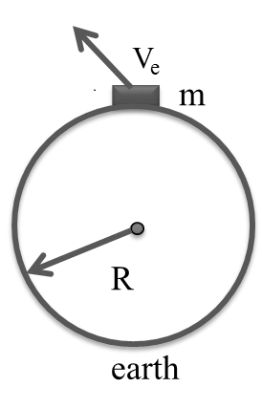
![]()
![]()
![]()
![]()
![]()
![]()
Ve = 11.3 km/sec
Independent of mass

 Kaysons Publication
Kaysons Publication
